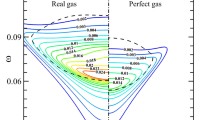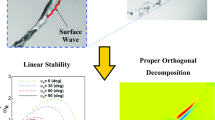Abstract
To analyze the fundamental physical mechanism which determines the damping effect of a riblet surface on three-dimensional transition several numerical simulations of spatial transition in a flat plate zero-pressure-gradient boundary layer above a riblet wall are performed in this study. Two types of forced transition scenarios are investigated. The first type of transition is defined by K-type transition induced by a dominant two-dimensional Tollmien–Schlichting (TS) wave and a weak spanwise disturbance. The second type of transition is purely excited by two oblique waves. By a qualitative analysis of the occurring maximum wall-normal and spanwise velocity components and the Fourier modes of the disturbances the two-dimensional TS waves are found to be amplified by riblets, whereas three-dimensional structures, i.e., Λ-, hairpin, and streamwisely aligned vortices, are damped. At oblique transition the breakdown to turbulence is delayed by the riblets compared to transition on a clean surface. The investigation of the near wall flow structure reveals secondary flows induced by the riblets and reduced wall normal ejections as well as a reduced downwash.
Similar content being viewed by others
References
Alkishriwi, N., Schröder, W., Meinke, M.: A Large-Eddy simulation method for low mach number flows using preconditioning and multigrid. Comput. Fluids 35(10), 1126–1136 (2006)
Bechert, D.W., Bruse, M., Hage, W., van der Hoeven, J.G.T., Hoppe, G.: Experiments on drag-reducing surfaces and their optimization with an adjustable geometry. J. Fluid Mech. 338, 59–87 (1997)
Belov, I.A., Enutin, G.V., Litvinov, V.N.: Influence of a flat plate streamwise and spanwise ribbed surface on the laminar-turbulent transition. Uch. Zap. TsAGI 17(5), 107–111 (1990)
Berlin, S., Lundbladh, A., Henningson, D.: Spatial simulation of oblique transition in a boundary layer. Phys. Fluids 6, 1949–1951 (1994)
Boris, J., Grinstein, F., Oran, E., Kolbe, R.: New insights into large eddy simulation. Fluid Dyn. Res. 10, 199–228 (1992)
Chernorai, V., Kozlov, V., Loefdahl, L., Grek, G., Chun, H.: Effect of riblets on nonlinear disturbances in the boundary layer. Thermophys. Aeromech. 13(1), 67–74 (2006)
Choi, H., Moin, P., Kim, J.: Direct numerical simulation of turbulent flow over riblets. J. Fluid Mech. 255, 503–539 (1993)
Ducros, F., Comte, P., Lesieur, M.: Large-eddy simulation of transition to turbulence in a boundary layer developing spatially over a flat plate. J. Fluid Mech. 326, 1–36 (1996)
Ehrenstein, U.: On the linear stability of channel flow over riblets. Phys. Fluids 8, 3194–3196 (1996)
Grek, G.R., Kozlov, V., Titarenko, S.: An experimental study of the influence of riblets on transition. J. Fluid Mech. 315, 31–149 (1996)
Hirt, G., Thome, M.: Rolling of functional metallic surface structures. CIRP Annals—Manufacturing Technology 57(1), 317–320 (2008)
Jeong, J., Hussain, F.: On the identification of a vortex. J. Fluid Mech. 285, 69–94 (1995)
Ladd, D.M., Rohr, J.J., Reidy, L.W., Hendricks, E.W.: The effect of riblets on laminar to turbulent transition. Exp. Fluids 14, 1–2 (1993)
Liou, M.S., Steffen, Jr., C.J.: A new flux splitting scheme. J. Comput. Phys. 107, 23–39 (1993)
Litvinenko, Y.A., Chernoray, V.G., Kozlov, V.V., Loefdahl, L., Grek, G.R., Chun, H.H.: The influence of riblets on the development of a Λ structure and its transformation into a turbulent spot. Physics - Doklady 51, 144–147 (2006)
Luchini, P., Trombetta, G.: Effects of riblets upon flow stability. Appl. Sci. Res. 54, 313–321 (1995)
Meinke, M., Schröder, W., Krause, E., Rister, T.: A comparison of second- and sixth-order methods for Large-Eddy simulations. Comput. Fluids 31, 695–718 (2002)
Neuman, D., Dinkelacker, A.: Drag measurements on V-grooved surfaces on a body of revolution in axial flow. Appl. Sci. Res. 48(1), 105–114 (1991)
Rai, M.M., Moin, P.: Direct numerical simulation of transition and turbulence in a spatially evolving boundary layer. J. Comput. Phys. 109(2), 169–192 (1993)
Renze, P., Schröder, W., Meinke, M.: LES of turbulent mixing in film cooling flows. Flow Turbul. Combust. 80, 119–132 (2008)
Rütten, F., Schröder, W., Meinke, M.: LES of frequency oscillations of the dean vortices in turbulent pipe bend flow. Phys. Fluids 17(2), 035,107.1–035,107.11 (2005)
Schlatter, P., Stolz, S., Kleiser, L.: Computational simulation of transitional and turbulent shear flow. In: Progress in Turbulence, Proc. ITI Conference on Turbulence (2005)
Schlichting, H., Gersten, K.: Grenzschicht-Theorie, 10th edn. Springer, Berlin(2006)
Schmid, P.J., Henningson, D.S.: Stability and transition in shear flows. Springer, New York (2001)
Spalart, P.R.: Direct simulation of a turbulent boundary layer up to R θ = 1410. J. Fluid Mech. 187, 61–98 (1988)
Author information
Authors and Affiliations
Corresponding author
Rights and permissions
About this article
Cite this article
Klumpp, S., Meinke, M. & Schröder, W. Numerical Simulation of Riblet Controlled Spatial Transition in a Zero-Pressure-Gradient Boundary Layer. Flow Turbulence Combust 85, 57–71 (2010). https://doi.org/10.1007/s10494-010-9251-x
Received:
Accepted:
Published:
Issue Date:
DOI: https://doi.org/10.1007/s10494-010-9251-x




